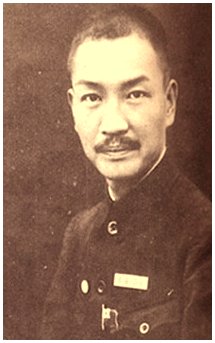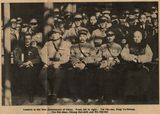Views
Dài Jìtáo 戴季陶 (1890-1949)
|
|
| Notable Associates: |
|
Dài Jìtáo 戴季陶 (1890-1949) was a politician and ideologue who supported Buddhist activities under the rubric of "National Salvation" (jiùguó 救國).
Contents |
Biography
Dài was born to a once prosperous family who had moved to Sìchuān from Zhèjiāng 浙江 during his great-great-grandfather's generation. His family made a living as potters and Dai was the youngest of four children, hence his name Jìtáo (Youngest Potter). Dái's mother (née Huáng 黃) taught him Buddhist practice from a young age.
Between 1902 and 1905 he studied in a school in Chéngdū 成都 that prepared students for studying in Japan. He traveled to Japan in 1905 to study law and politics at Nihon University 日本大学 in Tokyo. He became involved in publishing and editing revolutionary newspapers, and became a close confidant of Sūn Zhōngshān 孫中山 during political exile in Japan from 1912 to 1917.
In 1922 he had a dramatic experience during a suicide attempt en route by steamer from Hànkǒu 漢口 to Yíchāng 宜昌. Distraught at not being able to broker a truce between the Sìchuān warlords and Sūn Zhōngshān, he leaped into the river, only to be saved by a glowing halo of Buddha-light (fóguāng 佛光). Although he had learned Buddhist practice from his mother at a young age, after his early youth Dài had not engaged in it at all, but from this time he began to reconnect with Buddhism.[3]
Dài married Niǔ Yǒuhéng 鈕有恆 in Shànghǎi 上海 in 1911. She was a Buddhist from a young age and was very active in Buddhist practice. Her dharma name was Liánhuā 蓮花. She kept a vegetarian diet from 1929 and received the precepts from the Panchen lama 班禪 in 1931. She died in 1942.
Dài wrote about 90% of his works related to Buddhist subjects during the period 1930-1937. He asked Ōuyáng Jìngwú 歐陽竟無 to compile a selection of sutra readings for laypeople, which was published by the China Inner Studies Academy (Zhīnà nèixuéyuàn 支那內學院) in 1931 as Zàijiā bìdú nèidiǎn 在家必讀內典.
After the Mukden Incident of September, 1931, Dài convened a "Humane King who Protects the Country" Dharma assembly 仁王護國法會 on Baohua Mountain 寶華山 east of the capital of Nánjīng 南京. The Panchen lama 班禪 had entered the capital in June of that year, and he presided over the ceremonies, where many people took refuge in the Dharma.[4] Dài would organize other such assemblies as hostilities with Japan continued.
In 1933 he took the Dharma name Bùkōng 不空 or Bùkōng Jīngāng 不空金剛 in a Dharma assembly led by the Panchen Lama 班禪. He also received a Bhaisajyaguru (Medicine Buddha; Yàoshī 藥師) lustration (guàndǐng 灌頂) as well as a prediction of future enlightenment (shòujì 授記).
In 1940 he visited Buddhist sites in India and attempted to negotiate a political alliance with India against the Japanese based on the common Buddhist heritage of India and China.
From about 1937 he began to suffer from illness, specifically from 1941 he contracted rheumatism (shīqì 濕氣) and inflamed joints because of hiding in ditches during air raids. He often took solace in the fact that Shīlabhadra (Jièxián 戒賢; c. 521-651 CE), who also suffered from great pains, saw a Bodhisattva in a dream who told him that his pain was due to past evil acts, and that if he practiced assiduously he would recover. In 1947 he would write that in the past ten years he had constantly suffered from illness.
Dài committed suicide in Guǎngzhōu 廣州 in 1949 when the victory of the People's Liberation Army appeared assured.
Important Works
- "中國之宗教改革與救國事業" (The Reform of China's Religions and the Task of National Salvation.) Radio Broadcast on National Central Radio 中央廣播電臺 in Nánjīng 南京, March 22, 1933.
- "仁王護國法會發願文" (Text of vows made at Humane King who Protects the Country Dharma assembly) MFQ Vol. 180, p. 497
Also see List of Buddhist Works by 戴季陶
Gallery
| Images of Dài Jìtáo | |||||||||
| |||||||||
Notes
- ↑ The name of Amoghavajra, 705-774 CE
- ↑ Reported by Shì Dōngchū 釋東初, 中國佛教近代史, 下冊 (台北: 中華佛教文化館, 民國63 [1974]), 482.
- ↑ See 陳天錫, 增訂戴季陶(傳賢)先生編年傳記, 54.
- ↑ See 陳天錫, 增訂戴季陶(傳賢)先生編年傳記, 122.
References
- Chén Tiānxí 陳天錫, ed. and corr. Dài Jìtáo xiānshēng wéncún 戴季陶先生文存. 4 vols. Taipei: Zhōngguó guómíndǎng zhōngyāng wěiyuánhuì, 1959.
- Chén Tiānxí 陳天錫. Zēngdìng Dài Jìtáo (Chuánxián) xiānshēng biānnián zhuàn jì 增訂戴季陶(傳賢)先生編年傳記. Jìndài Zhōngguó shǐliào cóngkān xùbiān 近代中國史料叢刊續編, Vol. 43. [Taibei xian, Yonghe]: Wenhai chubanshe, [1967?].
- Shì Dōngchū 釋東初, ed. Dài Jítáo xiānshēng fóxué lùnjí 戴季陶先生佛學論集. Taipei: Huayan lianshe puti fotang yinhang, 1981.
- Shì Dōngchū 釋東初. Zhōngguó fójiào jìndàishǐ 中國佛教近代史, 2 vols. Taipei: Zhonghua fojiao wenhua guan, Mínguó 民國63 [1974] (pp. 481-496.) [1]
- Lín Jìng 林競 (1894-1962). "Bùkōng jūshì yǔ fójiào 不空居士與佛教" in Zhū Jiāhuá 朱家驊 et al., Dài Jìtáo xiānshēng shìshì shízhōunián jìniàn tèkān 戴季陶先生逝世十週年紀念特刊, [S.l. : s.n.], Mínguó 民國 48 [1959]: 39-44.



